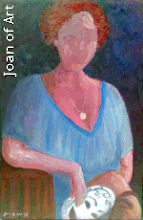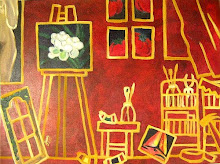For my artworks of human interest scenes of daily Pinoy life, my studies are usually taken from cell phone snapshots, deliberately not as clear as SLR shots so that instead of seeing them from a photographer's eye, I would see my subjects from an artist's impressionist eye.
I usually use my own shots for the sake of copyright and originality. But there are times that I could not be on location, for example, in a farm to make my derivative work of a farm scene.
But when I saw my friend Kristin's farm photographs, the lawyer that she is, I asked her permission for me to use her pictures for my oil pastel painting studies, and she was gracious enough to say yes.

This is her photograph of a farm workers planting rice. I did not intend to copy everything in the picture, being a derivative work, I just wanted to get inspiration from her rice plantation photo.
For the derivative work to be copyrightable, it must contain sufficient elements of originality that makes it a new work in its own right.

As I made my sketch in oil pastel (I don't use pencil on a toothed support such as sandpaper), I decided to rearrange the placement of some farm laborers. I didn't like the awkward position of the farm worker on the front left of the picture. He seemed to be a still greenhorn in the job. So I exchanged the other rice planter behind them to be the one up front. You can do anything in a painting such as changing the color of their shirts to uprooting unsightly trees and moving them elsewhere in the composition or not painting them at all.
I had a hard time deciding what color to use for the farm workers' skin tones, considering my limited palette. Sometimes it turned out too fair for farm workers, then when I used darker colors they don't come out of the painting as they should. And still I had to highlight the bulging muscles where the sunlight reflected on their skin.

This is the finished product of my oil pastel painting derivative work. However, when I took a picture of it, my camera exposure settings conked out, thus creating a misty effect in the background and an overall blurry outcome.
There's no way for me to take another picture of this painting anymore because I have arleady mailed it to Manila for the November 16, 2009 Panghimakas (Struggle) art exhibit at the Chief Justice Claudio Teehankee Center of the Ateneo Law School at Rockwell, Makati City.
Compared to other planting rice paintings by other artists, I decided not to use women as rice planters, because I have observed that if there are men around, the farm women actually don't to the backbreaking hard labor of planting rice. The women are typically more visible in harvest scenes.
The men in Philippine rural areas don't even wear traditional attire anymore. Notice that they are wearing ball caps in the painting and one wears a collared shirt. Thanks to the proliferation of ukay-ukay (rummage sale), where imported clothing from the U.S., Japan, etc., intended as relief goods are instead sold at very low prices.



No comments:
Post a Comment